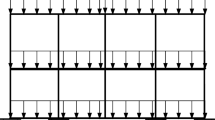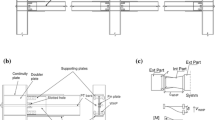Abstract
The horizontal stiffness of the isolated layer is reduced substantially by a friction pendulum bearing (FPB) toprotectthe structure from potential damages caused by earthquakes. However, horizontal stiffness is essential to progressive collapse resistance of structures. This paper presents a simplified model to assess the progressive collapse response of beam-pier substructure isolated by FPB. Progressive collapse resistance by flexural action of the beam and additional resistance owing to the horizontal restraining force was achieved. The influences of the equivalent radius and friction coefficient of the FPB, the applied axial force on the FPB, and span-depth ratio of the beam on the additional resistance were investigated. Simulations were conducted to verify the proposed model. The results show that progressive collapse resistance provided by horizontal restraining can be reduced as large as 46% and 88% during compressive arching action (CAA) and catenary action (CA), respectively. The equivalent radius of the FPB shows limited effect on the progressive collapse response of FPB isolated structures, but friction coefficient and applied axial force, as well as depth ratio of the beam, show significant influences on the additional progressive collapse resistance capacity. Finite element method (FEM) results are in good agreement with the result obtained by the proposed method.
Similar content being viewed by others
References
Adam J M, Parisi F, Sagasetac J, Lu X Z. Research and practice on progressive collapse and robustness of building structures in the 21st century. Engineering Structures, 2018, 173: 122–149
Stylianidis P M, Nethercot D A, Izzuddin B A, Elghazouli A Y. Study of the mechanics of progressive collapse with simplified beam models. Engineering Structures, 2016, 117: 287–304
Lu X Z, Lin K Q, Li C, Li Y. New analytical calculation models for compressive arch action in reinforced concrete structures. Engineering Structures, 2018, 168: 721–735
Qian K, Li B, Ma J. Load-carrying mechanism to resist progressive collapse of RC buildings. Journal of Structural Engineering, 2015, 141(2): 04014107
Qian K, Li B. Strengthening and retrofitting precast concrete buildings to mitigate progressive collapse using externally bonded GFRP strips. Journal of Composites for Construction, 2019, 23(3): 04019018
Li Y, Lu X Z, Guan H, Ye L P. Progressive collapse resistance demand of reinforced concrete frames under catenary mechanism. ACI Structural Journal, 2014, 111(5): 1225–1234
Qian K, Weng Y H, Li B. Improving behavior of reinforced concrete frames to resist progressive collapse through steel bracings. Journal of Structural Engineering, 2019, 145(2): 04018248
Lu X Z, Lin K Q, Li Y, Guan H, Ren P, Zhou Y. Experimental investigation of RC beam-slab substructures against progressive collapse subject to an edge-column-removal scenario. Engineering Structures, 2017, 149: 91–103
Lu X, Lu X, Guan H, Ye L. Collapse simulation of reinforced concrete high-rise building induced by extreme earthquakes. Earthquake Engineering & Structural Dynamics, 2013, 42(5): 705–723
Qian K, Li B. Analytical evaluation of the vulnerability of RC frames for progressive collapse caused by the loss of a corner column. Journal of Performance of Constructed Facilities, 2015, 29(1): 04014025
Xiao Y, Kunnath S, Li F W, Zhao Y B, Lew H S, Bao Y. Collapse test of three-story half-scale reinforced concrete frame building. ACI Structural Journal, 2015, 112(4): 429–438
Marjanishvili S, Agnew E. Comparison of various procedures for progressive collapse analysis. Journal of Performance of Constructed Facilities, 2006, 20(4): 365–374
Mehrdad S, Marlon B, Serkan S. Experimental and analytical progressive collapse evaluation of actual reinforced concrete structure. ACI Structural Journal, 2007, 104(6): 731–739
Setareh H S, Mashhadi J. Assessment of dynamic increase factor for progressive collapse analysis of RC structures. Engineering Failure Analysis, 2017, 84: 300–310
Liu M. A new dynamic increase factor for nonlinear static alternate path analysis of building frames against progressive collapse. Engineering Structures, 2013, 48: 666–673
Tsai M H, Lin B H. Dynamic amplification factor for progressive collapse resistance analysis of an RC building. Structural Design of Tall and Special Buildings, 2009, 18(5): 539–557
Li Y, Lu X Z, Guan H, Ye L P. An improved tie force method for progressive collapse resistance design of reinforced concrete frame structures. Engineering Structures, 2011, 33(10): 2931–2942
UFC-4-023-03. Design of Structures to Resist Progressive Collapse. Washington D.C.: Department of Defense (DoD), 2009
General Service Administration (GSA). Progressive Collapse Analysis and Design Guidelines for New Federal Office Buildings and Major Modernization Projects. Washington D.C.: The US General Service Administration, 2003
Tan Z, Zhong W, Meng B, Zheng Y, Duan S. Effect of various boundary constraints on the collapse behavior of multi-story composite frames. Journal of Building Engineering, 2022, 52: 104412
Corley W G, Sozen M A, Thornton C H, Mlakar P F. The Oklahoma City Bombing: Improving Building Performance Through Multi-hazard Mitigation. Washington, D.C.: Federal Emergency Management Agency, 1996
Diao M Z, Li Y, Guan H, Lu X Z, Gilbert B P. Influence of horizontal restraints on the behavior of vertical disproportionate collapse of RC moment frames. Engineering Failure Analysis, 2020, 109: 104324
Kang S B, Tan K H, Liu H Y, Zhou X H, Yang B. Effect of boundary conditions on the behaviour of composite frames against progressive collapse. Journal of Constructional Steel Research, 2017, 138: 150–167
Lim N S, Tan K H, Lee C K. Effects of rotational capacity and horizontal restraint on development of catenary action in 2-d RC frames. Engineering Structures, 2017, 153: 613–627
Pham A T, Lim N S, Tan K H. Investigations of tensile membrane action in beam-slab systems under progressive collapse subject to different loading configurations and boundary conditions. Engineering Structures, 2017, 150: 520–536
Zhong W, Meng B, Hao J. Performance of different stiffness connections against progressive collapse. Journal of Constructional Steel Research, 2017, 135: 162–175
Du Y, Zhu X, Lu X Z, Song X, Tan Z. Analysis on progressive collapse resistance of long complicated isolated structures. China Civil Engineering Journal, 2012, S1: 90–95 (in Chinese)
Du Y, Shi C. Progressive collapse performance of isolated structures subjected to multi-direction coupled dynamic excitation. Engineering Mechanics, 2019, 36(6): 248–256
Du Y, Duan H, Xu T. Vertical progressive collapse mechanism and influencing factors of base-isolated structures. Journal of Vibration and Shock, 2018, 37(5): 257–260
Khatibinia M, Gholami H, Kamgar R. Optimal design of tuned mass dampers subjected to continuous stationary critical excitation. International Journal of Dynamics and Control, 2018, 6(3): 1094–1104
Kamgar R, Samea P, Khatibinia M. Optimizing parameters of tuned mass damper subjected to critical earthquake. Structural Design of Tall and Special Buildings, 2018, 27(7): e1460
Kamgar R, Khatibinia M, Khatibinia M. Optimization criteria for design of tuned mass dampers including soil—structure interaction effect. International Journal of Optimization in Civil Engineering, 2019, 9(2): 213–232
Dadkhah M, Kamgar R, Heidarzadeh H, Jakubczyk-Galczyńska A, Jankowski R. Improvement of performance level of steel moment-resisting frames using tuned mass damper system. Applied Sciences (Basel, Switzerland), 2020, 10(10): 3403
Xue Q, Zhang J, He J, Zhang C, Zhou G. Seismic control performance for pounding tuned massed damper based on viscoelastic pounding force analytical method. Journal of Sound and Vibration, 2017, 411: 362–377
Kamgar R, Gholami F, Zarif Sanayei H R, Heidarzadeh H. Modified tuned liquid dampers for seismic protection of buildings considering soil-structure interaction effects. Civil Engineering (Shiraz), 2020, 44(1): 339–354
Guan X, Zhang J, Li H, Ou J O U J. Semi-active control for benchmark building using innovative TMD with MRE isolators. International Journal of Structural Stability and Dynamics, 2020, 20(6): 2040009
Fitzgerald F, Sarkar S, Staino A. Improved reliability of wind turbine towers with active tuned mass dampers (ATMDs). Journal of Sound and Vibration, 2018, 419: 103–122
Shariati A, Kamgar R, Rahgozar R. Optimum layout of nonlinear fluid viscous damper for improvement the responses of tall buildings. International Journal of Optimization In Civil Engineering, 2020, 10(3): 411–431
Salimi M, Kamgar R, Heidarzadeh H. An evaluation of the advantages of friction TMD over conventional TMD. Innovative Infrastructure Solutions, 2021, 6(2): 1–12
Kamgar R, Heidarzadeh H, Samani M. Evaluation of buckling load and dynamic performance of steel shear wall retrofitted with strips made of shape memory alloy. Scientia Iranica, 2020, 1(1): 1–27
Kamgar R, Dolatabad Y A, Samani M R. Seismic optimization of steel shear wall using shape memory alloy. Iran University of Science & Technology, 2019, 9(4): 671–687
Dadkhah M, Kamgar R, Heidarzadeh H. Improving the nonlinear seismic performance of steel moment-resisting frames with minimizing the ductility damage index. SN Applied Sciences, 2021, 3(1): 1–14
Tavakoli R, Kamgar R, Rahgozar R. Seismic performance of outrigger braced system based on finite element and component-mode synthesis methods. Civil Engineering (Shiraz), 2020, 44(4): 1125–1133
Kamgar R, Rahgozar P. Optimum location for the belt truss system for minimum roof displacement of steel buildings subjected to critical excitation. Steel and Composite Structures, 2020, 37(4): 463–479
Kamgar R, Shojaee S, Rahgozar R. Rehabilitation of tall buildings by active control system subjected to critical seismic excitation. Asian Journal of Civil Engineering, 2015, 16(6): 819–833
Kamgar R, Mohammad R. Numerical study for evaluating the effect of length-to-height ratio on the behavior of concrete frame retrofitted with steel infill plates. Practice Periodical on Structural Design and Construction, 2022, 27(1): 04021062
Tavakoli R, Kamgar R, Rahgozar R. Optimal location of energy dissipation outrigger in high-rise building considering nonlinear soil-structure interaction effects. Periodica Polytechnica Civil Engineering, 2020, 64(3): 887–903
Kamgar R, Tavakoli R, Rahgozar P, Jankowski R. Application of discrete wavelet transform in seismic nonlinear analysis of soil-structure interaction problems. Earthquake Spectra, 2021, 37(3): 1980–2012
Zayas V A, Low S S, Mahin S A. A simple pendulum technique for achieving seismic isolation. Earthquake Spectra, 1990, 6(2): 317–333
Li Y, Lu X Z, Guan H, Ye L P. An energy-based assessment on dynamic amplification factor for linear static analysis in progressive collapse design of ductile RC frame structures. Advances in Structural Engineering, 2014, 17(8): 1217–1225
Jian H, Zheng Y. Simplified models of progressive collapse response and progressive collapse-resisting capacity curve of RC beam-column substructures. Journal of Performance of Constructed Facilities, 2014, 28(4): 04014008
Xu F J. Studies on displacement-based seismic design methodology of reinforced concrete frame-core wall structures. Dissertation for the Doctoral Degree. Beijing: Tsinghua University, 2006 (in Chinese)
Acknowledgements
This research was supported by the National Key Research and Development Program of China (No. 2017YFC0703603).
Author information
Authors and Affiliations
Corresponding author
Rights and permissions
About this article
Cite this article
Zhang, J., Ding, Y. & Guan, X. Study of the mechanics of progressive collapse of FPB isolated beam-pier substructures. Front. Struct. Civ. Eng. 16, 718–728 (2022). https://doi.org/10.1007/s11709-022-0815-3
Received:
Accepted:
Published:
Issue Date:
DOI: https://doi.org/10.1007/s11709-022-0815-3




